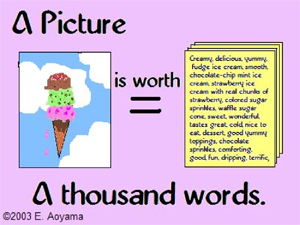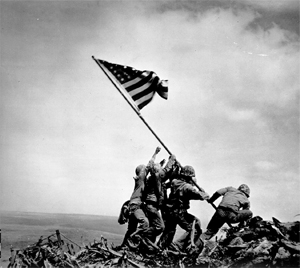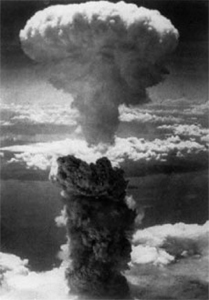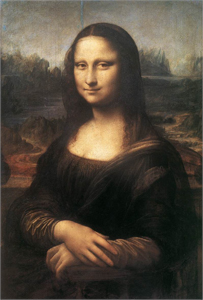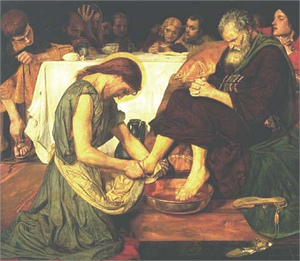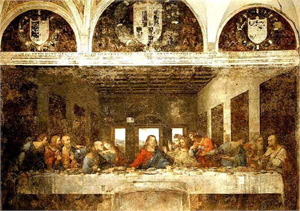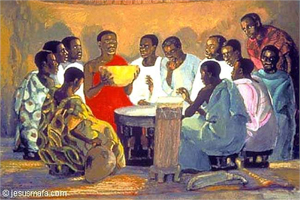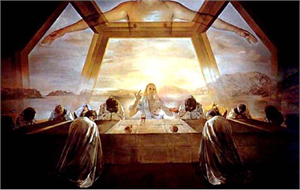
Christmas
Easter
Pentcoest
All Saints
Christ The King
Confirmation
Palm/Passion
Reformation
Stewardship
Books of the Bible
Lenten Series
Christmas Dramas
Videos
Series A - Matthew
Series B - Mark
Series C - Luke
Series D - Other
To contact
Edward F. Markquart
info@sfs.com

Series B A Picture is Worth a Thousand Words John 13:1-17, 31-35 Would you please complete the following proverb for me? “A picture is worth a ___________________.” Yes, a thousand words. The title of the sermon for tonight is: A picture is worth a thousand words. This proverb makes sense to us. That is, we know that pictures are often more powerful than words. We know that complex stories and complex feelings can be told with just a single picture. You can see this theme in the picture below. The picture is dripping with feeling.
On the left you can see a tripled deckered ice cream cone. On the right, you can see numerous words that describe the ice cream cone. Which of the two looks tastier to you? More appealing? More delicious? The picture on the left. This proverb, a picture is worth a thousand words,” is often called a Chinese proverb, but in actually, it was invented in 1921 by an American, Frank Barnard, for an advertisement that was appearing on the sides of street cars. His ad on the sides of streeetcars said, “One look is worth a thousand words.” In 1927, Barnard wrote another ad which said “a picture is worth 10,000 words.” Barnard called it a Chinese proverb so that people would take it more seriously. It wasn’t long after that that this “Chinese” proverb was said to have come from Confucius. “A picture is worth 10,000 words.” That sounds like Confucius. What are some of the most graphic images in our minds today? What are some of THE pictures of all time? Pictures that we know so well that our hearts and minds exclaim, “Wow,” when we see them. This famous photograph of earth as photographed from space. This picture is worth more than 10,000 words, is it not?
We know that our Earth may be the only planet in the universe which has life on it. What a jewel! What a gem! What a place to live! Another famous image worth more than a thousand words or even worth more than 10,000 words was the raising of the American flag on Iwa Jima. This picture became a symbol. It is so graphic, so visual, so vivid and striking. http://www.iwojima.com/raising/lflage.gif
We in the 20th century remember the mushroom cloud over Hiroshima after the nuclear bomb was dropped on it. We remember that nightmare in our minds. Yes, that picture is worth more than 10,000 words. http://www.worldpress.org/images/090403hiroshima.jpg
Some of the greatest pictures that have been etched into our minds are of famous paintings such the Mona Lisa by Leonardo. Again, this picture is worth more than 10,000 words and maybe even more than ten million words. How could any amount of words capture the subtlety of expressions found in this painting? http://www.dickran.net/img/mona_lisa.jpg
Some of the greatest pictures that have been etched into our minds are of famous sculptures such as THE PIETA by Michelangelo. Can any human expression of words capture the mystical essence of this sculpture? I think not.
These pictures that we have just seen are etched into our minds. We remember them. We see them. We feel them. Those pictures have been absorbed into our hearts. These pictures drip with the invisible nuances of feelings and emotions. Our hearts go “wow” when we see them. Knowing that a picture is worth more than a thousand words, we also have pictures from Biblical scenes deeply imbedded into our minds. In the Biblical times, there were no artists drawing or painting pictures of scenes from Jesus’ life. It was against the second commandment about not making any graven images. Instead, during Biblical times, we have authors who paint pictures with words. Jesus himself was a master of painting pictures with words in his parables. One of the most graphic scenes from Jesus’ life are the events which happened at The Last Supper. Two events happened at The Last Supper and both scenes are so graphic, so visual, so vivid and striking. The first graphic event at The Last Supper is where Jesus washed the feet of his disciples. There were no artists present to paint that scene but there were authors who could paint with words so realistic that we can see this sight within our imaginations. We can see and feel the disciples arguing with each other on the way to the Last Supper, arguing about which one was the greatest disciple. We can imagine Jesus overhearing their remarks of bravado. We can see Jesus taking the towel of a servant girl and a basin of water. We can see Jesus kneeling down and beginning to wash the feet of each disciple. We can hear the deafening silence. We can see Jesus coming to Simon Peter and Simon Peter resisting Jesus, “Not me Jesus. You are not going to wash my feet.” We can hear Jesus say to Peter, “If I don’t wash your feet, you cannot be my disciple.” Jesus did. After Jesus washed the feet of the twelve disciples, we can imagine Jesus standing up and saying to them, “How happy you will be if you put this into practice. How happy you will be if you discover what it means to be a servant.” In our minds, we can see it all. We hear the following words echo down the centuries, “For Christ did not count equality with God a thing to be grasped, but Christ humbled himself, taking the form of a servant.” We can see it all in the imagination of our minds. A scene painted with words. After many centuries, this scene, which had been previously painted with words, was then painted with brushes. And here is what it looked like. This is my favorite painting of the foot washing. It is by Ford Madox Brown in 1865, English.
What do you see? We can see and feel feelings that are all over this canvas. Immediately, you see Jesus in the foreground. You see Jesus’ right hand softly washing Peter’s right foot. You see Jesus’ left hand touching his heel. You see the towel of the servant girl wrapped around Jesus waist. That dishtowel around Jesus’ waist became a symbol of service in the church. You see Jesus’ head bowed down in humility, focusing on the task at hand. You see that Jesus’ body is located below Simon Peter’s, the master below the servant. You then notice Peter. See the older burly disciple, Simon Peter. What was in Peter’s mind? His hands are folded, almost in a mood of contentment. Notice the other disciples in the background silently and intently watching Jesus. Notice a disciple at the left reaching down to take off his shoe, getting ready for Jesus to wash his feet. Notice a disciple in the darkened background who is covering his face perhaps in shame. On the far right, notice young John, the youngest of the disciples, immediately behind Simon Peter. What is he thinking? This still life painting is dripping with feeling. Ten thousand words could not imitate this painting. In this scene, we are invited by Jesus to become servants like he was a servant. This painting is an invitation. We are invited by Jesus to live a live of humble service to the needs of others, not elevating ourselves above others nor elevating ourselves above tasks that we feel are beneath our dignity. Here within our congregation, we do the foot washing ceremony every year on Holy Thursday. Every year, we re-enact this ritual. We select a person who is a symbol of a person with a servant’s heart. For example, the first person to have their feet washed here at Grace Lutheran in our foot washing ceremony was Anne Burdick back in 1974. Anne and her husband Al went over many evenings and played pinochle with Ted and Mildred Olson. Mildred had the worst case of arthritis in her hands that you had ever seen, and Anne was constantly caring for Mildred with her phone calls, notes and coming over to play cards. Anne Burdick has always had the heart of a servant. Grace Lutheran Church is composed of people like Anne Burdick who has the heart and actions of a servant. Grace Lutheran Church is made up of people who have humble hearts like Jesus Christ who invited his disciples to be humble servants. Not to think more highly of one’s self but to live a life that meets the needs of others. The foot washing is so graphic, so visual, so vivid, so vibrant. A second event happened at the Last Supper, and this event is so graphic, so visual, so vivid, so vibrant. We can actually see in our minds the twelve disciples gathered around a long table at the last supper, eating their Passover meal. We can see Jesus taking the bread, the matzos, and saying, “This is my body given for you. Eat this in remembrance of me.” We can see him taking a cup filled with wine and saying to his disciples, “Take and drink. This is the blood of the new covenant which is shed for you and for many for the forgiveness of sins.” Artists have captured this scene on canvas many centuries later. We will briefly look at three paintings of the Lord’s Supper. Closely observe the scene of the Last Supper by Leonardo. This is the most famous painting of the Lord’s Supper.
First, focus on Jesus in the center. The window behind his head accentuates the presence of Jesus. Jesus Christ was really present at that first meal and is really present in our meal of Holy Communion tonight. You can feel “the real presence” of Christ in this painting. Notice the disciples. They are in four groups of three. You can almost feel the questions in the disciples heart’s immediately after Jesus had told them, “One of you is going to betray me.” All the disciples are asking, “Is it I?” The table is buzzing with conversation among the small groups of disciples, “Is it I?” I like the following painting by Mafa, an African artist whose Jesus is always black and so are his disciples. The settings from Mafa are always an African village. Notice Jesus, who is always dressed in red in Mafa’s paintings. You can almost hear Jesus saying the words, “This is my blood shed for you and for all people for the forgiveness of sins.” In this painting, you notice the size of the bowl which is so central to the painting. This bowl was filled with wine, filled with the forgiveness of God for all people of all generations for all centuries. That is what Holy Communion is all about: The sacred words, “given and shed for you and for all people for the forgiveness of sins.”
And, below, the painting by Salvador Dali, the Spanish genius. Notice Christ, the predominance of Christ, in the center of the painting. The head of Christ is almost perfectly in the center of the painting and Christ is the perfect center of Holy Communion. Holy Communion is about Jesus Christ and his forgives for us. Notice the wine before him, the two halves of bread on the front of the table, the reverence of the disciples. Notice the reverence of the disciples with their heads bowed down as if each disciple was deep in prayer. At Holy Communion class for the fifth graders, we were teaching reverence, a deepest respect for God and the things of God. You can feel the reverence in this painting. Holy Communion is a time when our hearts slow down and reverently worship the presence of God. Holy Communion is a time of deepest prayer. Notice Jesus’ arms at the top of the painting, that his arms are stretched out, that his forgiveness is for all people in the world. “This is my blood shed FOR YOU and for ALL people.” This gift is both personal and universal at the same time. This gift of forgiveness is FOR YOU PERSONALLY and for EVERYBODY.
Yes, a picture is worth a thousand words. Often, a picture is worth more than 10,000 words. Amen. |
